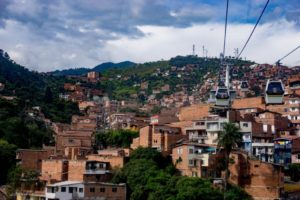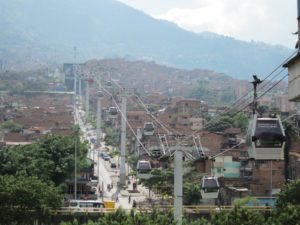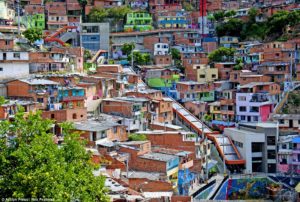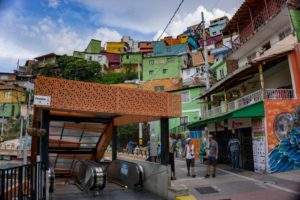- June 02, 2017
- 0 Comments
- In Accessible Design and Construction
- By Peter Stratton
Written by Camilo Vasquez, Accessibility Specialist

A view of the comunas in Medellin, Colombia
There are cities around the world with the potential to conjure up negative images the moment you mention the name. My hometown of Medellin, Colombia is certainly one of those cities. It is no secret that Medellin is synonymous with Pablo Escobar, the notorious drug lord who paralyzed Colombia with constant violence and chaos over two decades ago. In 1988, TIME magazine named it the most dangerous city in the world. By 1991, it became the murder capital of the world. Yet in 2013, Medellin was announced the “Innovative City of the Year” by USA’s Urban Land Institute. How did Medellin go from a haven of narco-terrorism to becoming a hub of innovation? This transformation has been attributed to the use of urban infrastructure as a tool for inclusion, which was very apparent during my recent trip.
During my visit, I was taken aback by how much the city had changed since my last trip 6 years ago. As I took the metro on my first day there, it became immediately apparent how Medellin’s new urban developments have enhanced accessibility and connectivity for its people. Two of the most impressive features that have improved access tremendously are the MetroCable and the outdoor escalator.

Medellin’s MetroCable system
The MetroCable is the world’s first modern urban aerial cable car system. The system provides easy access to the city center ending isolation for those who live in the predominantly disadvantaged hilltop communities. Prior to the completion of the MetroCable, residents living in the steeply sloped city slums, or comunas, faced a long and dangerous commute down the mountainside to end up in the city center; a trip that took hours on foot.

The orange-roofed outdoor escalator, transporting residents from the hilltop comunas to the city center.
Not too far from Comuna 13’s MetroCable exists a giant orange-roofed outdoor escalator. In the upper reaches of the comunas, the streets are so steep that they give way to staircases. Walking from the upper comunas to the city center equates to climbing the stairs of a 28 story building. The escalator transports people from the hilltop comunas to the city center within minutes, transforming a painful commute into an enjoyable one and providing inhabitants from all socioeconomic backgrounds with easy access to the city.

The entrance to the outdoor escalator in Comuna 13
Similar to the MetroCable, strategic placement of the escalator not only integrates the communities perched in the mountaintops, but it is also a symbol of rebirth for neighborhoods that have experienced extensive neglect and violence.
There is no question that Medellin’s transportation system is a marvel. It is a system that strives to incorporate all persons, regardless of status or physical ability. But that is not to say that the city is perfect. There are definitely cracks in the city’s built environment. The lack of ramps and curb ramps on some of the city’s walkways, and even the lack of accessible entrances to commercial buildings is no rarity. Much of this can be attributed to the lack of enforceable codes and standards, like those issued under the Americans with Disabilities Act (ADA) or the Fair Housing Act (FHA) in the United States. Despite all of this, Medellin’s innovative efforts continue to demonstrate that social equity, inclusion, and accessible transport go hand in hand.
